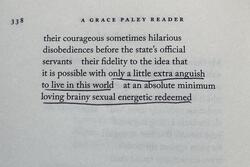Remembering the Uprising of the 20,000
 On a cold November morning onehundred years ago today, more than 20,000 immigrant workers--mostly young Jewishwomen--took to the streets of the lower east side of New York, kicking off aneleven-week general strike of the shirtwaist industry knows as the Uprising ofthe 20,000. The strike exploded the assumption of most unionleaders that women workers were too capricious to be organized or to be effectivestrikers, and led to the "needle trades" becoming one of the best organizedfields in the United States.
On a cold November morning onehundred years ago today, more than 20,000 immigrant workers--mostly young Jewishwomen--took to the streets of the lower east side of New York, kicking off aneleven-week general strike of the shirtwaist industry knows as the Uprising ofthe 20,000. The strike exploded the assumption of most unionleaders that women workers were too capricious to be organized or to be effectivestrikers, and led to the "needle trades" becoming one of the best organizedfields in the United States.
Though often described in popularaccounts at the time and since as a spontaneous uprising, the industry-wide strikewas actually the culmination of three years of intense organizing by youngJewish women like Pauline Newman, Rose Schneiderman, and Clara Lemlich. Thesewomen were farbrente Yidishe meydlekh (fiery Jewish girls, or Jewesseswith Attitude, as we might call them), but they were by no means hotheaded.Rather, they were committed activists with years of work experience, a clearpolitical grasp of the garment industry, and audacity to boot.
A series of smaller strikes in thesummer of 1909 led up to the massive November walk-out. Garment workers werefed up with the low wages, long hours, unsafe working conditions, and sexualharassment they faced on the job. Out on strike, these young women facedadditional threats--thugs hired by the companies beat strikers on the picketlines; police arrested them on trumped-up charges; and judges railed againstthem in court, fining them and sentencing workers as young as ten years old tothe workhouse.
By November, with union strikefunds nearly depleted, it seemed as if the workers might lose. But the smallLocal 25 of the International Ladies Garment Workers Union (ILGWU), whichrepresented shirtwaist makers, instead recommended a general strike that wouldshut down the entire shirtwaist industry. Thousands of women came to a meetingat Cooper Union on November 22 to discuss the proposal. After hours ofinconclusive speeches from (mostly male) union leaders, Clara Lemlich--a leaderof one of the small walk-outs--demanded to speak and cut through the rhetoric. "I am a working girl, one of those who areon strike against intolerable conditions. I am tired of listening to speakerswho talk in general terms. What we are here to decide is whether we shall orshall not strike. I offer a resolution that a general strike be declared--now." Herwords ignited her fellow workers, and the crowd took the traditional Jewishoath "If I forget thee O Jerusalem..."(replacing "Jerusalem"with "union") to support the general strike.
Like other important femaleactivists whose calculated political actions are rewritten as spontaneous andaccidental (Rosa Parks, for example), Lemlich was described in contemporaryaccounts as an anonymous hero, "a wisp of a girl, still in her teens," withoutany political context. In fact, she was 23 and had been working and organizingfor 8 years. For years, she had been arguing to older, male union leaders thatthe ILGWU would never succeed without the inclusion of women. She served on theexecutive board of Local 25 of the ILGWU, and was likely recognized by manyworkers when she took the podium at Cooper Union. In the months leading up tothe Uprising of the 20,000, Lemlich had already suffered six broken ribs andbeen arrested 17 times. (After the Uprising, she went on to a life-long careeras a community organizer, suffragist, communist, and peace activist, as well aswife and mother.)
The strike was only partiallysuccessful. Workers won some of their demands, such as a 52-hour week, atleast four paid holidays per year, and no discrimination against union members;membership of the ILGWU swelled; and a five year wave of garment strikes spreadacross the country. The demands for safer working conditions, however, were notmet--to tragic ends for many women, most notably the workers at the TriangleShirtwaist Factory in New York,which burned in 1911, killing 146 workers.
Despite these mixed results, theUprising of the 20,000 taught garment workers, and the labor movement ingeneral, some lasting lessons. Its leaders learned the importance of buildingcoalitions--with union men, who still held most of the leadership positions;with women workers of other racial and ethnic backgrounds; and with progressivemiddle- and upper-class women, who were important allies in the strike. Membersof the Women's Trade Union League protected garment workers on the picket linewith their presence, which tended to discourage violence from police and thugsand to attract media attention and some sympathy when violence did erupt. (Muchlike the white volunteers of the civil rights movement's Freedom Summer in 1964brought national attention to the daily brutality of life in Mississippi forblacks.)
The strike also became both a"symbol and catalyst," as scholar Annelise Orleck put it, of working women'spolitics, shaping an integrated class and gender consciousness into what cameto be known as "industrial feminism"--a model of social change that grew out ofthe interactions of working women and feminist activists and the impact of shopfloor experiences on women's political lives.
One hundred years ago today, Jewishwomen changed the shape of the American labor movement. But while the world hastransformed in the century since then, the garment industry actually doesn'tlook all that different. It is still peopled by immigrants, mostly women, manyworking in sweatshop conditions. It is still strengthened by coalition buildingand by a political approach that melds class and gender consciousness. We woulddo well not only to remember Lemlich and the women of 1909, but to honor theirmemories by taking their hard-won lessons out of the history books and into the21st century labor movement.






